Written by Madeleine Shaw, (Dartmouth College), Student Correspondent for CET Jordan, Fall 2023
Wadi Mujib River Hike
I didn’t think I was going to make it— the water was coming down too hard, and I wanted to turn back. Strangers told me to close my eyes and just go for it, but everything in me resisted climbing up the ladder. Nevertheless, I told myself there was no going back as I walked into the waterfall and clung tight onto the slippery rungs. Step by step, I pulled myself up, unable to see or hear anything but the gushing water plummeting down on me. With a gasp, I’d reached the top. Cheers, claps, and water-splashing Jordanians awaited me after myself and twelve of my classmates overcame yet another waterfall on our Wadi Mujib river hike.
I’ve hiked less than a handful of times in my life and wouldn’t call myself a great swimmer, so I wasn’t quite sure what I was getting myself into when I signed up to go on a day trip to Mujib Biosphere Reserve with several of our jiran (Jordanian neighbors). I’d been assured that I would do fine on the hike as long as I kept an open mind, but I was definitely unprepared for both the strenuousness and beauty of Mujib. Our group traversed up and down waterfalls and rock structures within a stunning canyon for four hours. The gorge culminated in a spacious pool with an epic final waterfall, perfect for taking photos to commemorate the demanding hike.
Much like learning Arabic, the hike was quite literally an uphill battle, as the obstacles got harder and harder, and I increasingly questioned my will to keep going. With each challenge I conquered, however, I gained a sense of confidence that I could take on the next. Indeed, the two-hour journey back made the whole trip worth it; the current that we’d fought against on our way there transformed into a much-needed lazy river on the way back. Drifting back with my friends beside me, I felt immensely proud for having completed the hike and excited to go back in the future.
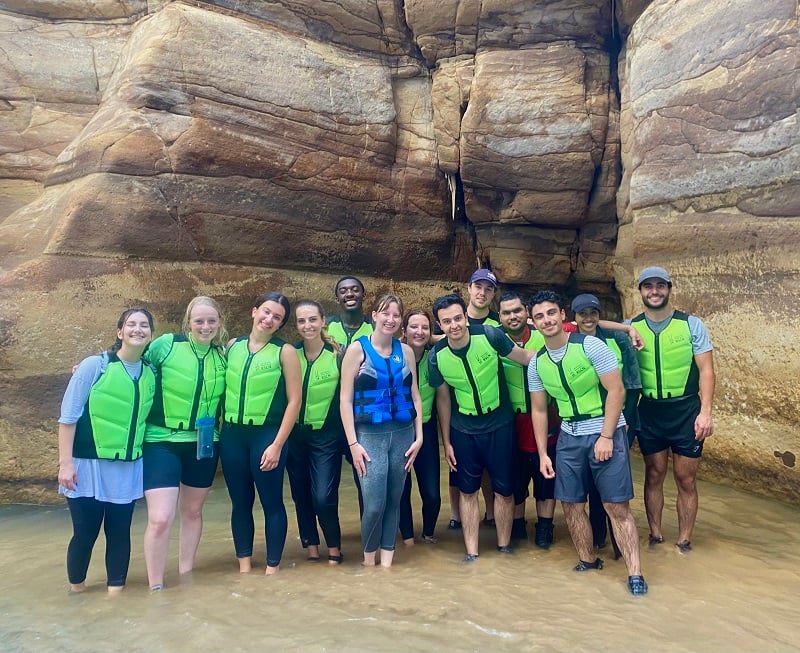
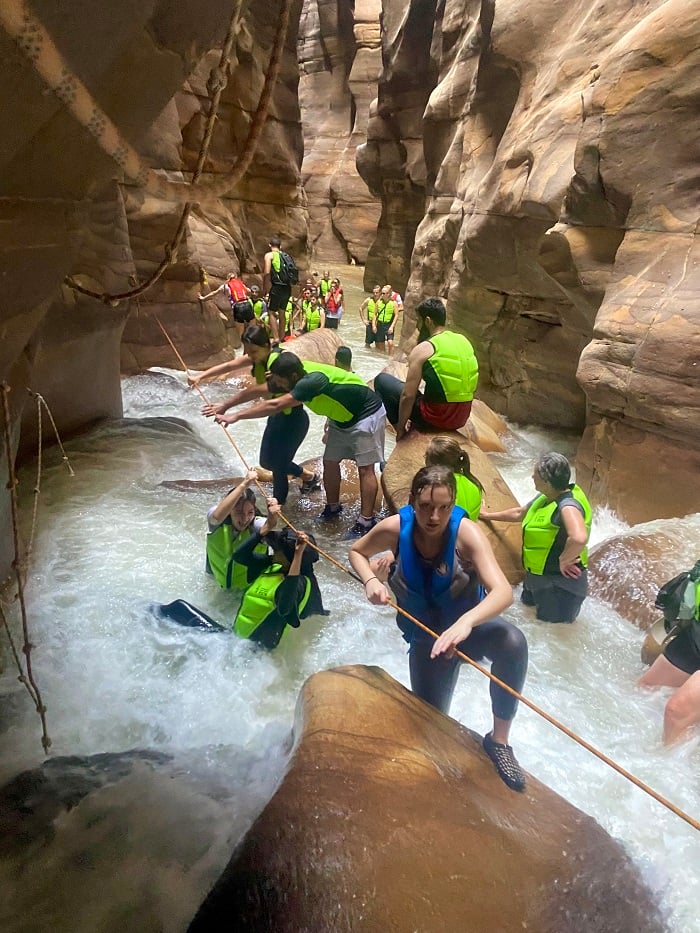
This past weekend, a dozen of us traversed to Wadi Mujib, the lowest nature reserve on Earth. The strenuous yet breathtaking river hike took about four hours to complete and was definitely one of the most memorable excursions of my life.
The Dead Sea
Finding out we had a day off of classes for the Prophet’s Birthday, several friends and I resolved to spend a morning avoiding our Arabic homework at the Dead Sea. After a 45-minute taxi ride from Amman, we arrived at the Dead Sea Spa Resort— one of many hotels at the Dead Sea that offer beach-goers a private beach day pass. Upon arriving at the resort, we were at first struck by the five-minute walk from the hotel to the beach with incremental signs reading, “X years ago, the water level was here.” We learned that the Dead Sea recedes about four feet yearly and is expected to dry completely in 15-30 years. Clearly, if you find yourself in Jordan, the Dead Sea (like Wadi Mujib) is a must-visit.
Floating in the salty sea was an out-of-this-world experience, although I wouldn’t recommend shaving your legs the night before (oops!) It’s impossible to sink in the Dead Sea, and the nutrient-rich mud we rubbed on our bodies is supposed to make your skin youthful and healthy. After spending half an hour in the sea, we cooled off by jumping into one of the resort’s pools and enjoying fresh juice on lounge chairs overlooking the sea. The break was much needed and incredibly restful, plus where else in the world can you float in a giant salt bath covered in mud?
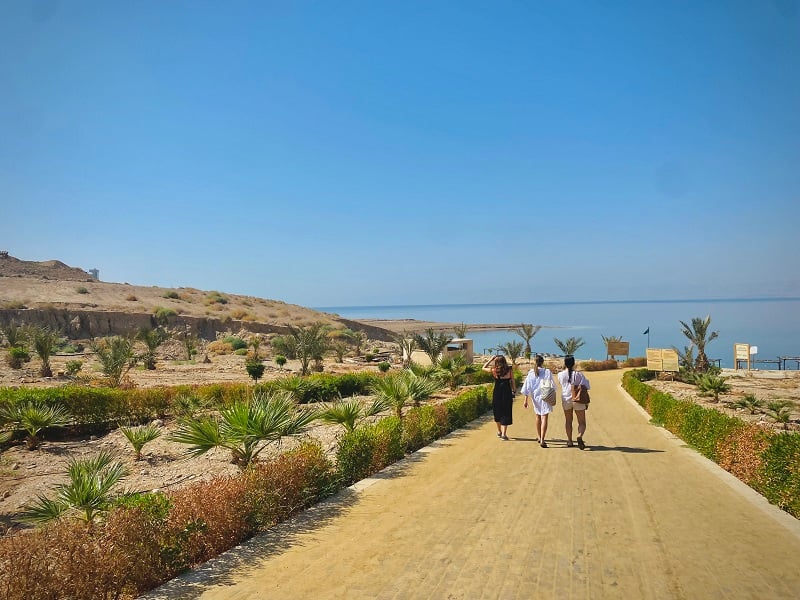
My friends and I walk down to the Dead Sea, about a 45-minute drive from Amman. We spent a day off of classes soaking up the sun (literally) floating in the salty sea with a $20 day pass at the Dead Sea Spa Hotel– totally worth it.
Jerash
Another sunny day this past September, our CET crew packed into a school bus headed to Jerash, a beautiful city north of Amman known for its perfectly preserved Roman ruins. No day trip is complete without singing and dancing, of which there was plenty on the ride to Jerash. That morning, two of our jiran graciously organized a home-cooked breakfast for us in their family’s picturesque grape vineyard. After helping cook vegetables, we settled down on a carpet. We helped lay out a selection of traditional Jordanian breakfast foods, including hummus, falafel, labneh, dawali (stuffed grape leaves), galayet bandora (sauteed tomatoes), and cucumbers.
Our bellies and arms full of home-cooked treats, we headed out in search of ripe grapes to pick. Thankfully, the tasty green grapes burst with flavor and certainty helped alleviate the rays of sun beaming down on us. After collecting several boxes, we headed down the road to our next destination, only to stumble across a herd of goats just off the road. A kind shepherd agreed to let our group meet and take photos with the curious animals, amusingly known as maaz in Arabic due to their distinctive sound.
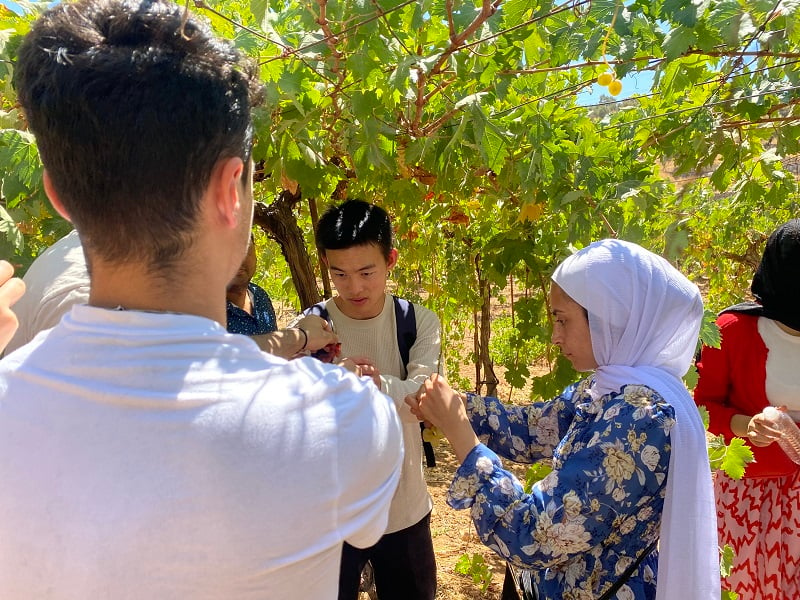
I think this picture captures the beauty of our grape-picking excursion in Jerash. And believe me, these weren’t just normal grapes; bursting with flavor, these might have been the sweetest fruits I’ve ever eaten.
Following our grape-picking and goat-meeting excursion, our group sat down for musakhan— spiced chicken with caramelized onion and yogurt, considered to be the national dish of Palestine. We ate at Beit Souf, a beautiful female-run restaurant that is now sponsored by UNICEF and offers visitors a lovely café, gift store, and even cooking classes. Our final stop of the day was our neighbor’s family home, where we met her mother and siblings and were offered tea, sweets, and stories of life in Jerash. Another great day trip from Amman, I look forward to returning to Jerash to visit the Roman ruins and perhaps take a cooking class at Beit Souf.
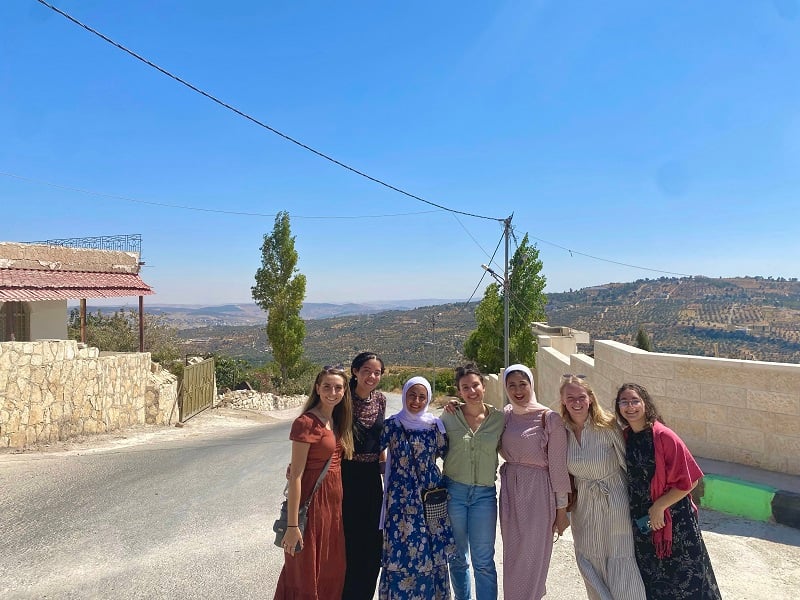
After spending the day picking grapes, herding goats, and exploring Jerash, my friends and I take a picture in front of the beautiful Jordanian countryside. Included in the picture are two of our lovely jiran or Jordanian neighbors that live in our apartment complex and plan activities for CET students like this day in Jerash!
As-Salt
Last but certainly not least is the city of As-Salt, located just 45 minutes northwest of Amman. Compared to the busy streets of Amman, As-Salt was a calm yet equally breathtaking town known for its hospitality and history of religious harmony between Muslims and Christians. My roommates and I spent a day exploring As-Salt, starting with the Historic Old Salt Museum. The visitor’s center is built into a historic Ottoman mansion that reveals the city’s rich history as a former trade capital. After meeting and taking photos with curious locals, we explored As-Salt’s bustling market (suq) on Hammam Street and enjoyed lemon mint juice on the rooftop of Aktham’s 1881 Coffee House, a scenic café that, like the town of As-Salt, has a long history.
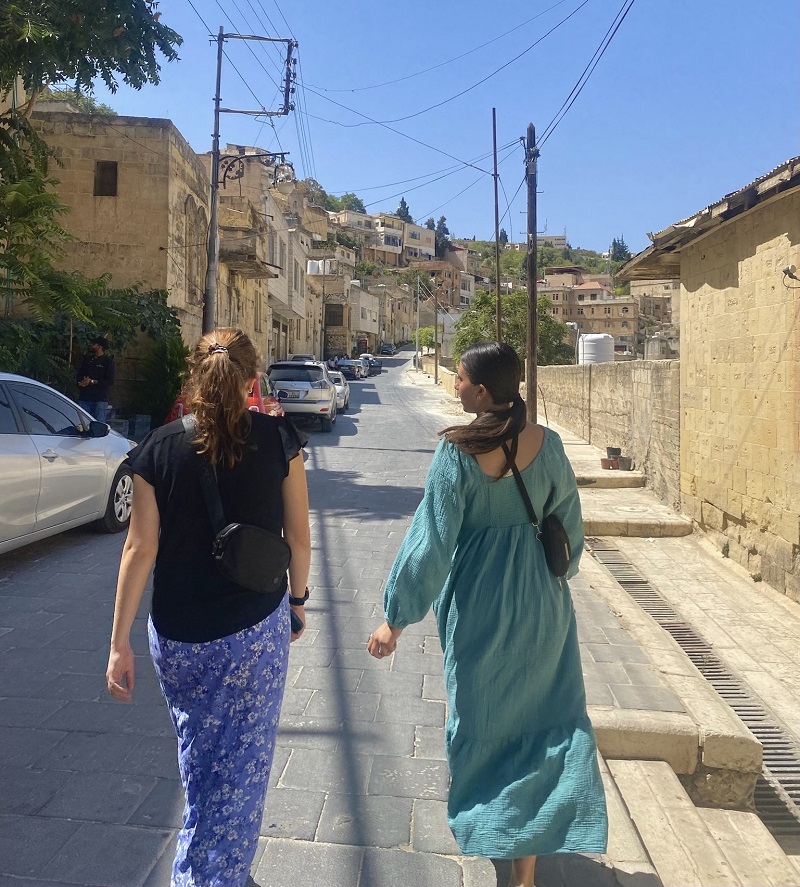
My other roommate and I walk through the scenic streets of As-Salt. The town is now a UNESCO heritage site due to its history of “Tolerance and Urban Hospitality.” Sure enough, we met many friendly and curious residents in As-Salt and it was definitely a trip to remember!
While Wadi Mujib, Jerash, and As-Salt may be slightly lesser-known destinations than Petra and Wadi Rum (which I can’t wait to visit in a few weeks), they should certainly be at the top of any visitor’s list.
In writing this blog, I hope that my experiences can inspire others to get off the beaten path and say yes to any adventure they have the opportunity to join in on. Studying Arabic or any other language in the classroom can get you far, but getting out, exploring, talking with locals, and learning about the culture from Jordanians themselves will undoubtedly get you farther. Here’s to many more adventures in Jordan!